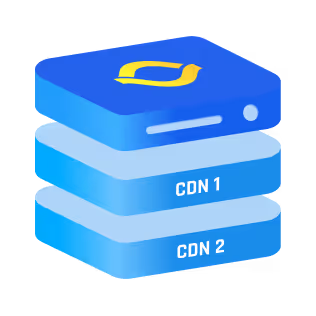Ever wondered how websites serve you only a portion of a video, audio file, or large document instead of making you download the whole thing? That’s where these services use a technique called byte-range requests.
These requests allow your browser to ask a server for specific chunks of data, making things faster and more efficient. While this might seem decent on paper, it holds much more significance in reality.
What Are Byte-Range Requests?
A byte-range request is a feature of the HTTP protocol that lets your device fetch only a specific part of a file from a server. Instead of downloading an entire file, your browser can request small chunks, also called "ranges." This is especially useful for large files, streaming services, or resuming interrupted downloads.
Here’s how it works:
- Your browser sends an HTTP Range Header with the desired range of bytes.
- The server responds with the requested data range if it's available.
For example, if you’re watching a video online, the player uses byte-range requests to fetch the next chunk of the video while you’re watching the current one.
Why Are HTTP Range Requests Useful?
Byte-range requests improve efficiency, save bandwidth, and enhance user experience. Here’s how they help:
- Streaming Media: Streaming platforms use byte-range requests to let you skip forward or backward in videos without reloading the entire file.
- Resuming Downloads: If a download is interrupted, it can pick up where it left off instead of starting over.
- Large File Optimization: For files like PDFs, only the portion you’re viewing is downloaded, saving time and data.
Difference Between Partial and Full Content Delivery
When it comes to downloading content from a server, there are two main approaches: partial content delivery and full content delivery. Here's where Byte-Range requests make a difference:
How Do HTTP Range Headers Work?
The HTTP Range Header is key to making byte-range requests. When your browser sends a request, it includes the Range field specifying the desired bytes. For instance:
Range: bytes=0-499
This means, “Please send me the first 500 bytes of the file.”
If the server supports range requests, it responds with a 206 Partial Content status and the requested chunk of data. The server also includes a Content-Range header in its response, showing the range of bytes sent:
Content-Range: bytes 0-499/1000
This indicates that the server sent the first 500 bytes out of a 1000-byte file.
416 Requested Range Not Satisfiable Error
Sometimes, your byte-range request might fail, resulting in a 416 Requested Range Not Satisfiable error. This happens when the requested range isn’t valid. For example:
- The range exceeds the file size.
- The file doesn’t exist or can’t be accessed.
If you try to request bytes 1000-1500 of a 900-byte file, the server will return a 416 error because there’s no data to fulfill your request.
To avoid this, always ensure the requested range is within the file’s size.
Byte-Range Requests in HTTP/2 and HTTP/3
Byte-range requests get even better with HTTP/2 and HTTP/3:
- HTTP/2:
- Multiplexing: Fetch multiple ranges at once over one connection.
- Compressed Headers: Smaller Range headers for faster communication.
- HTTP/3:
- Lower Latency: Faster setup with QUIC means quicker byte delivery.
- Resilient Streams: If one range fails, others aren’t affected.
- Better Streaming: Perfect for smooth video and audio delivery.
HTTP/2 and HTTP/3 supercharge byte-range requests for blazing-fast file handling.
{{cool_component}}
Using Byte-Range Requests with cURL
If you want to experiment with byte-range requests, tools like cURL make it easy. For example, you can use the following command to fetch the first 500 bytes of a file:
curl -H "Range: bytes=0-499" https://example.com/file.mp4
This sends the Range header to the server and retrieves only the specified range.
You can also use cURL Accept Encoding to ensure the server compresses the data if possible. For example:
curl -H "Range: bytes=0-499" --compressed https://example.com/file.mp4
Here, --compressed tells the server to use compression if it’s supported, saving even more bandwidth.
Common Use Cases for Byte-Range Requests
Here are some real-world examples of byte-range requests in action:
- Video and Audio Streaming: Platforms like YouTube and Spotify use byte-range requests to let users jump to specific timestamps without loading the entire file.
- Software Updates: Large updates often download in chunks, making the process more efficient.
- Web Applications: PDF viewers and similar tools load only the portions of a document that the user views.
- CDNs (Content Delivery Networks): Byte-range requests reduce server load by fetching only necessary data.
How Byte-Range Requests Improve CDN Performance
Byte-range requests make CDNs faster and more efficient by:
- Saving Bandwidth: Only the requested file chunks are delivered, not the whole file.
- Smarter Caching: Frequently accessed file segments, like the start of a video, are cached separately for faster access.
- Reducing Latency: Small, specific requests mean quicker delivery times, especially for streaming.
- Resuming Downloads: Interrupted downloads or streams can pick up without reloading the whole file.
- Load Balancing: CDNs split file chunks across multiple nodes to handle heavy traffic better.
Byte-range requests are a powerhouse for delivering large files efficiently.
Conclusion
Byte-range requests are a game-changer for optimizing file transfers and streaming. Try experimenting with cURL commands or inspecting network requests in your browser’s developer tools to see byte-range requests in action!



.png)
.png)
.png)






